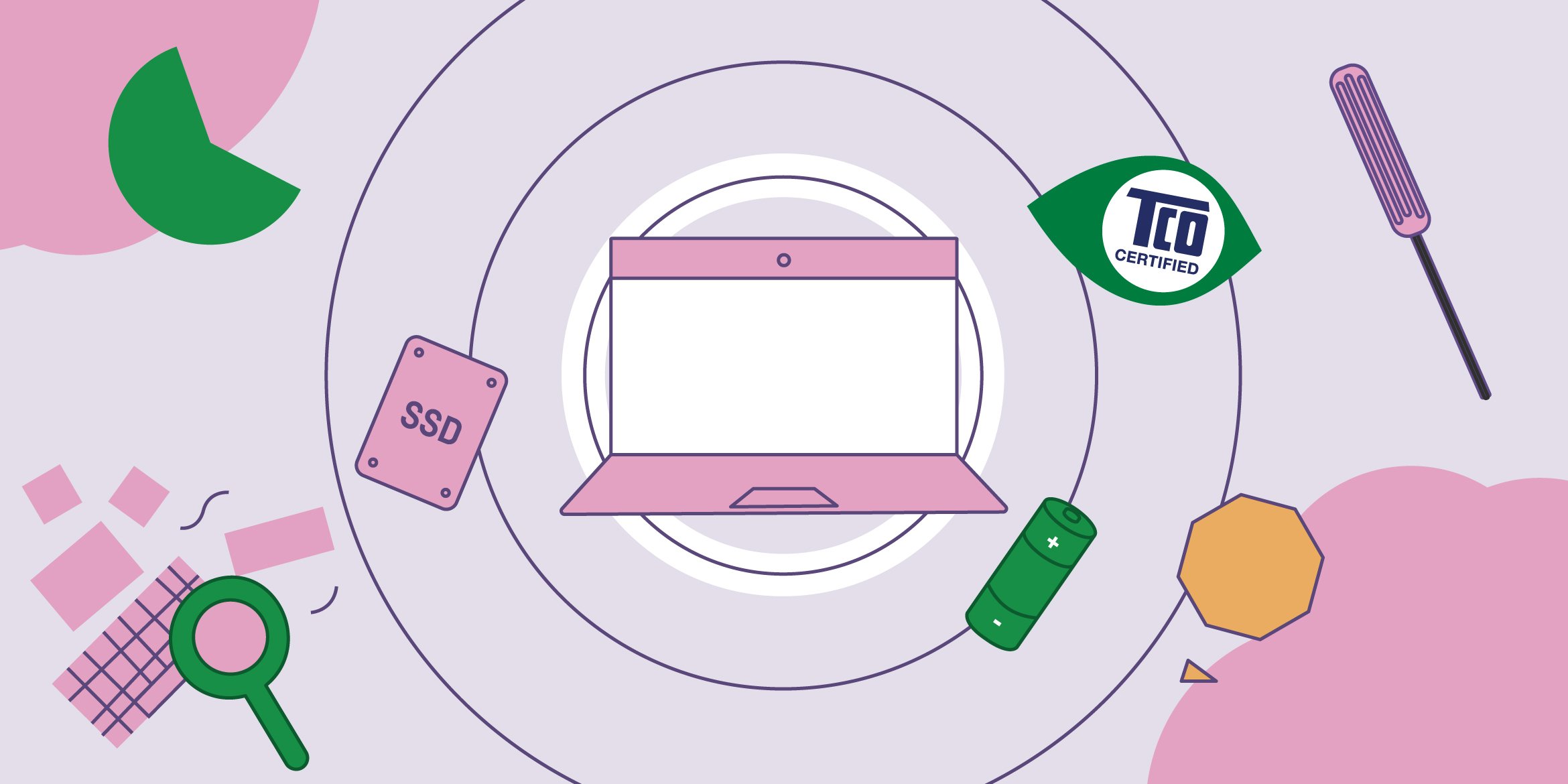In a new report, TCO Development, the organization behind the TCO Certified IT product sustainability certification (included in AASHE STARS), walks you through concrete steps for implementing more circular management of IT products.
In this article, Clare Hobby, Global Purchaser Engagement Director highlights key findings from the report Impacts and Insights: Circular IT Management in Practice.
The circular economy is the next frontier of sustainability, as we aim toward eliminating waste and keeping products in circulation. What does this mean for IT hardware? How can campuses approach the IT life cycle – from procurement to recovery – in a way that supports the circular economy, reduces emissions and toxic e-waste?
We need to move from a linear to a circular economy
In a linear economy, we take virgin resources to make products, which are too often discarded once we’re done using them — often after a relatively short use time.
Sadly, this “take make, use and dispose” approach applies to a variety of products that we use every day, such as clothing and electronics. In IT, the effects of the linear economy are especially alarming. Toxic e-waste is the fastest growing waste stream in the world, at an annual rate of over 50 million metric tonnes. Other concerns include the depletion of natural resources and carbon emissions resulting from the manufacturing and use of computers and other devices.
The bottom line is that moving to a more circular approach to IT has the vast potential to conserve resources, extend the lives of products and prevent waste altogether. It’s a monumental task, but one that starts now, and involves us all.
In a circular economy, resources are handled in a more responsible way – meaning they are used longer, recovered and then re-used as feedstock for new products. The goal is to extend product lifetimes and recirculate all materials, eliminating waste altogether.
Achieving a waste-free, circular economy sounds ambitious – and it is. In most product categories, reaching the goal will require ecosystem change – fundamental shifts in how we think about product design, how we buy, sell, and use products. Concepts like product-as-a-service are beginning to challenge existing business models as buyers ask “Do I really need to own this computer, or do I just need access to my content?”
While an audacious, circular vision is essential, too much utopian thinking may be our worst enemy. Because as product buyers and users, there are grass roots actions we can take now that will show immediate benefit, while we take a long term aim at a circular future.
Isn’t circularity all about recycling?
Before deciding on what steps to take, it’s important to be familiar with some basic concepts about what circularity means in practice. I often get asked “Isn’t circularity all about recycling?”, to which I typically answer, “Yes. And no”
The basic premise of the circular economy is to keep products and materials in use as long as possible, at their highest value, and then recover them for re-use in new products. For IT, this means extending the usable life of the products we already have and those we intend to buy in the future.
Therefore, circular IT management should be considered in four main hierarchical priorities, beginning with longer use.
- Longer use – including service agreements, maintenance, product sharing
- Refurbish – upgrading, selling to refurbisher, buying refurbished
- Remanufacture – rebuild products, buying remanufactured
- Recycle – through manufacturer take back, accredited recyclers.
So recycling definitely has a place in the circular economy, but is best considered once longer use, refurbishing and remanufacturing options have been explored first. One reason for this recommendation is that the bulk of a computer’s lifetime emissions occur in the manufacturing phase, so buying a more energy efficient model may in fact increase your carbon footprint. Longer use of existing products is the best place to start.
The challenge for IT buyers now is how to know if you’re making the most circular choices when buying, using and treating IT products throughout the life cycle.
Digging into the facts – circularity and a notebook computer
Solutions for a more circular approach to IT hardware and these four priorities are already available. What’s lacking is how much we use them.
Our latest report, Impacts and Insights: Circular IT Management in Practice, lays out how a circular approach to IT could help solve critical sustainability challenges, and delivers practical advice on what immediate steps IT buyers and users can take to get there.
To illustrate, the report takes a closer look into how to manage notebook computers responsibly. Around 170 million notebook computers are produced and sold globally every year. Even though their manufacture requires large amounts of energy, as well as a number of finite natural resources, their service life is often short.
In higher education, and other IT using organizations, an average IT hardware contract is based on a use cycle of around four years. At the end of that use phase, it can be difficult to find responsible end of life options, resulting in too many devices ending up as e-waste even though they are fully functional. This way of handling IT products goes against the principles of the circular economy, where products should be kept in use for as long as possible, to conserve resources and retain value.
Based on interviews with experts in IT procurement and sustainability, the report outlines four conclusions that can help IT managers and purchasers make more circular choices:
- extending product life cuts greenhouse gas emissions. Adding two years to product life reduces emissions by 30 percent
- carbon footprint is reduced when existing notebook computers are upgraded instead of replaced with new.
- buying new – often more energy efficient – devices doesn’t compensate for the emissions during the manufacture of that new device, which is where the majority of a product’s emissions take place.
- circular solutions are better from a financial perspective. By extending lifetime from four to six years, the cost of purchasing and using a complete computer workstation can actually be reduced by 28 percent.
Siddharth Prakash, a senior researcher at the Oeko-Institut in Germany, offered some insights on what needs to happen for the IT industry to become more circular and sustainable. “We need to focus more on the design and production phase. In a circular economy, you want durable products that can be repaired and reused as much as possible. You need high quality components and a modular design where the battery and other parts can be taken out without destroying the product. You also need to be conscious about material choices. For instance, by limiting the diversity of plastic types in a product, avoiding certain coatings on plastics and avoiding toxic substances in materials, recycling rates can improve.”
One more year!
If extending the notebook purchasing cycle by two years seems like a big step to take, know that even one year product life extension has a substantial impact. Keeping notebook computers in use for five years instead of four reduces greenhouse gas emissions by 64.9 kg carbon dioxide equivalent per notebook, or 17.4 percent. For an organization with 1,000 employees, this means a reduction of 129,800 kg over a 10 year period.
Next steps for IT purchasers – get circular by getting started !
For IT purchasers and managers wanting to drive the circular economy, the most important thing is to get started. There are many ways to do this – and the report offers many concrete suggestions from the experts for taking this first step.
Read the experts 33 hands-on tips in the latest report Impacts and Insights – Circular IT management in practice
Use TCO Certified as part of AASHE STARS to drive circular IT
TCO Certified is the sustainability certification for IT products, covering both environmental and supply chain social responsibility. TCO Certified is used by IT purchasers around the world to identify more sustainable IT office products and data center products in 11 categories.
TCO Certified is also included in the AASHE STARS rating system and can be used to register your IT purchasing credit.
By specifying TCO Certified in your IT procurement policy and procurement, you’re supporting progress toward the circular economy. By including the certification in your product specifications, you get access to products that are durable, repairable, upgradeable and recyclable.

Clare Hobby
Clare Hobby oversees purchaser engagement programs for TCO Development, the organization behind TCO Certified, the global independent sustainability certification for IT products. TCO Certified is used by procuring organizations and the IT industry to drive environmental and supply chain responsibility in the IT ecosystem.
Clare is a board member of the Sustainable Purchasing Leadership Council and SPLC’s Technical Advisory Group for IT Hardware, the Clean Electronics Production Network, UN Environment’s One Planet Network and the Canadian Public Procurement Council. She holds Masters degrees from Northwestern University and the University of Melbourne, Australia and Executive Education in Sustainability Leadership at Harvard.




